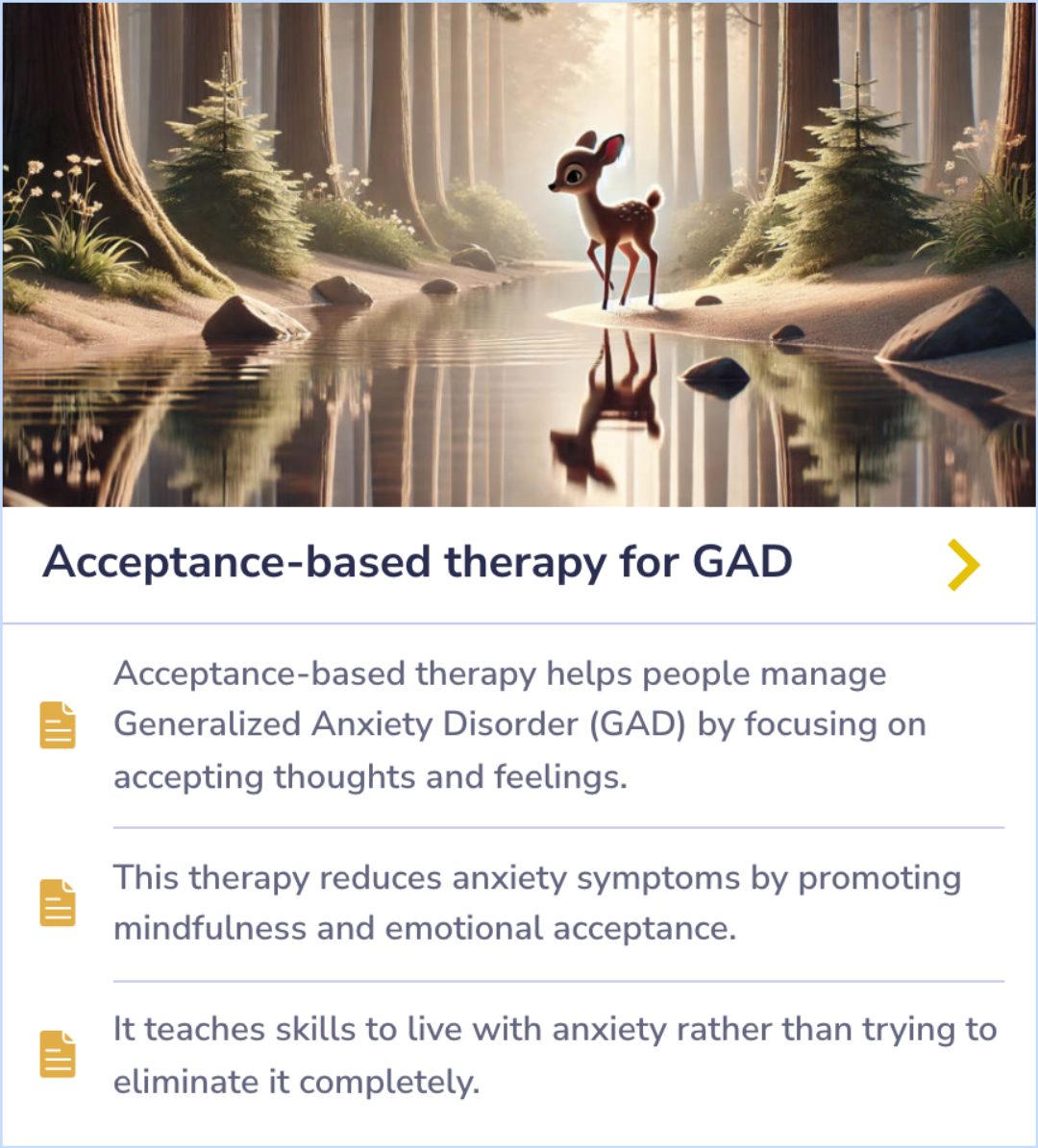Generalized Anxiety Disorder Papers
Visual Abstract
Perseverative thought: a robust predictor of response to emotional challenge in generalized anxiety disorder and major depressive disorder
Perseverative thought as a predictor in GAD and MDD
November 25, 2024
author
Ruscio AM, Seitchik AE, Gentes EL, Jones JD, Hallion LS
journal
Behav Res Ther
Date Published
2011 Dec
Why link to a visual abstract?
What is a visual abstract?
Original
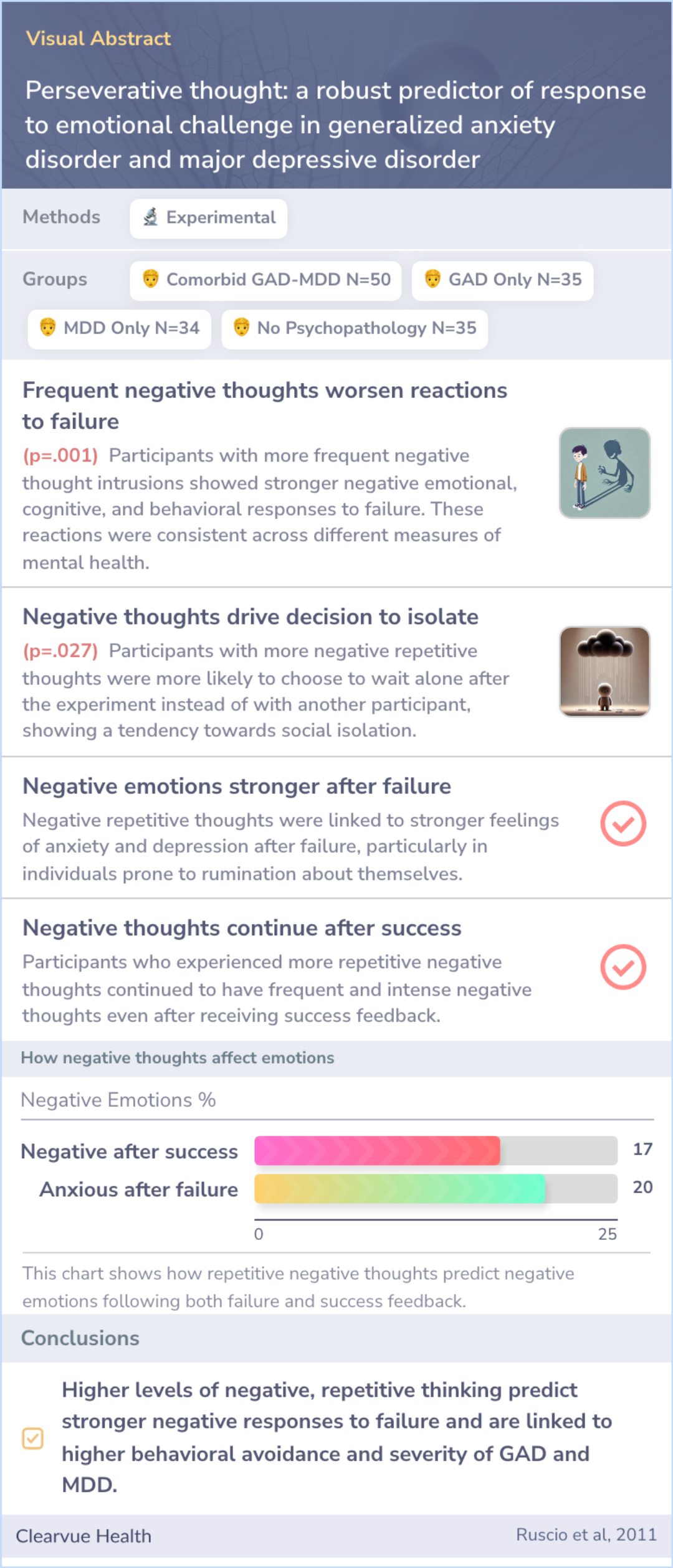
Study Summary
🔬
What They Studied
They studied whether negative, repetitive thinking is a common risk factor for both generalized anxiety disorder and major depressive disorder.
💡
What They Found
They found that higher levels of negative, repetitive thinking predict stronger negative responses to failure and are linked to higher behavioral avoidance and severity of GAD and MDD.
📚
What This Means
These findings align with the current understanding that excessive worry and maladaptive thought patterns contribute to the symptoms and severity of generalized anxiety disorder and major depressive disorder.
Study Summary
Study Overview
This study aimed to explore how negative, repetitive thinking affects anxiety and depression. It looked specifically at generalized anxiety disorder (GAD) and major depressive disorder (MDD).
The researchers found that a core process of perseverative thinking is shared between GAD and MDD. This common thought process could help in understanding how these disorders interact and may open doors for improving treatment strategies that address both conditions simultaneously.
The researchers found that a core process of perseverative thinking is shared between GAD and MDD. This common thought process could help in understanding how these disorders interact and may open doors for improving treatment strategies that address both conditions simultaneously.
Abstract: background
Generalized anxiety disorder (GAD) and major depressive disorder (MDD) frequently co-occur, yet the reasons for their comorbidity remain poorly understood. In the present experiment, we tested whether a tendency to engage in negative, repetitive thin...more

Core Process Impact
"The present study examined whether a core process of perseverative thinking cuts across GAD and MDD and contributes to risk in these disorders."
Treatment Implications
"Evidence for a fundamentally similar thought process in GAD and MDD would have direct implications for treatment."
Emotional Disorder Mechanism
"Our findings suggest that PT predicts response to stress, and as such, may play a role in maintaining both GAD and MDD."
Study Summary
Methods
The study involved a mixed group of adults, divided into those with both GAD and MDD, those with only GAD, those with only MDD, and those with no history of mental health issues. Participants received feedback on tasks showing either failure or success.
Researchers measured negative thought intrusions during a focused breathing task and analyzed these thoughts as predictors for participants' responses to the feedback.
Researchers measured negative thought intrusions during a focused breathing task and analyzed these thoughts as predictors for participants' responses to the feedback.
Abstract: methods
A mixed sample of adults with comorbid GAD-MDD (n = 50), GAD only (n = 35), MDD only (n = 34), or no lifetime psychopathology (n = 35) was administered noncontingent failure and success feedback on consecutive performance tasks. Perseverative thought...more

Study Summary
Results
Participants who frequently had negative thoughts during the baseline breathing task showed stronger negative reactions to failure. This negativity lingered even after successes.
Higher levels of repetitive negative thinking were linked to avoidance behavior, negative emotions, and traits associated with anxiety and depression, indicating severity and presence of both GAD and MDD.
Higher levels of repetitive negative thinking were linked to avoidance behavior, negative emotions, and traits associated with anxiety and depression, indicating severity and presence of both GAD and MDD.
Abstract: results
Participants reporting more frequent negative thought intrusions at baseline, irrespective of thought content or diagnostic status, exhibited a stronger negative response to failure that persisted even after subsequent success. Higher PT over the cou...more
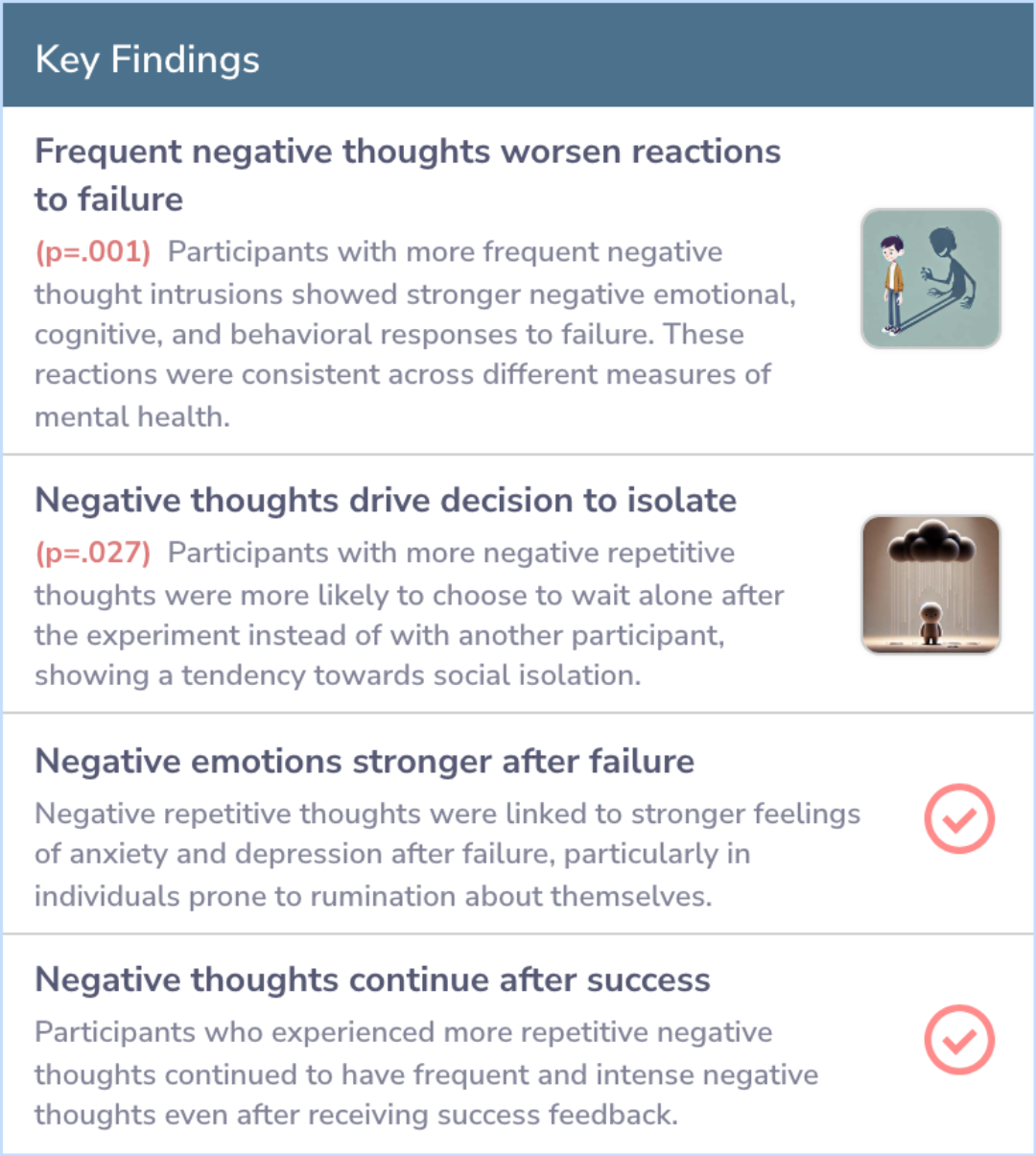
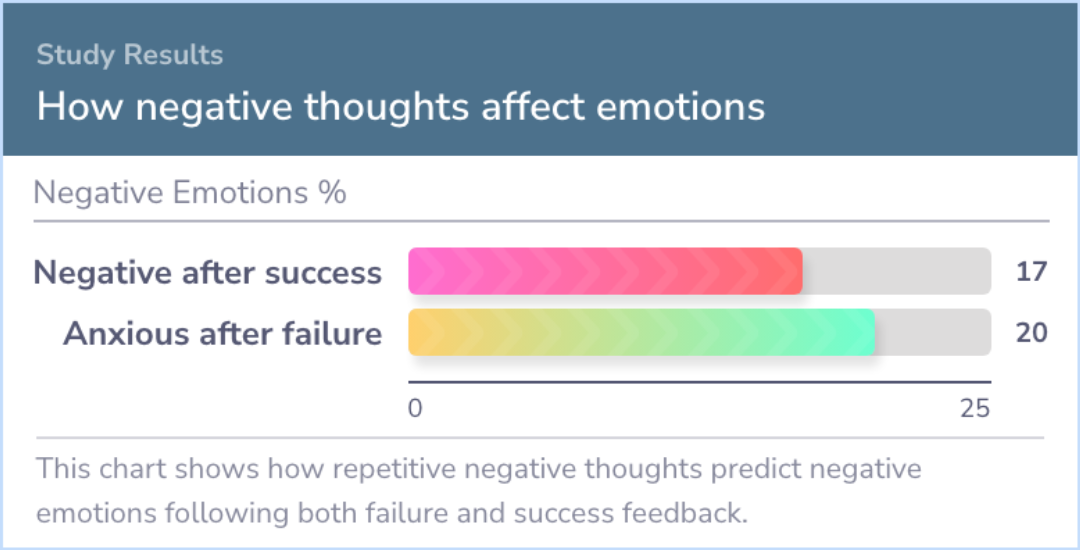
Study Summary
Conclusions
The findings suggest that repetitive negative thinking is a shared trait between GAD and MDD, potentially leading to worse outcomes in these disorders.
Understanding this common risk factor might help in developing treatments that address both conditions simultaneously.
Understanding this common risk factor might help in developing treatments that address both conditions simultaneously.
Abstract: conclusions
These findings provide evidence for a broadly-defined PT trait that is shared by GAD and MDD and contributes to adverse outcomes in these disorders.

Background Information
Patient Guide
🔗
Comorbidity of GAD and MDD
GAD and MDD frequently occur together, increasing complexity and complicating treatment.
😟
Excessive and Persistent Worry
GAD involves persistent, unrealistic worry without obvious reason, impacting daily activities.
🌍
Biological and Environmental Causes
GAD's origins include genetic predisposition, neurotransmitter imbalances, and stressful environments.
🔗
Treatment Combinations for GAD
Effective GAD treatment often combines cognitive behavioral therapy with medications.
📝
Screening and Diagnosis
GAD-7 tool screens GAD severity; physical tests exclude other potential causes.
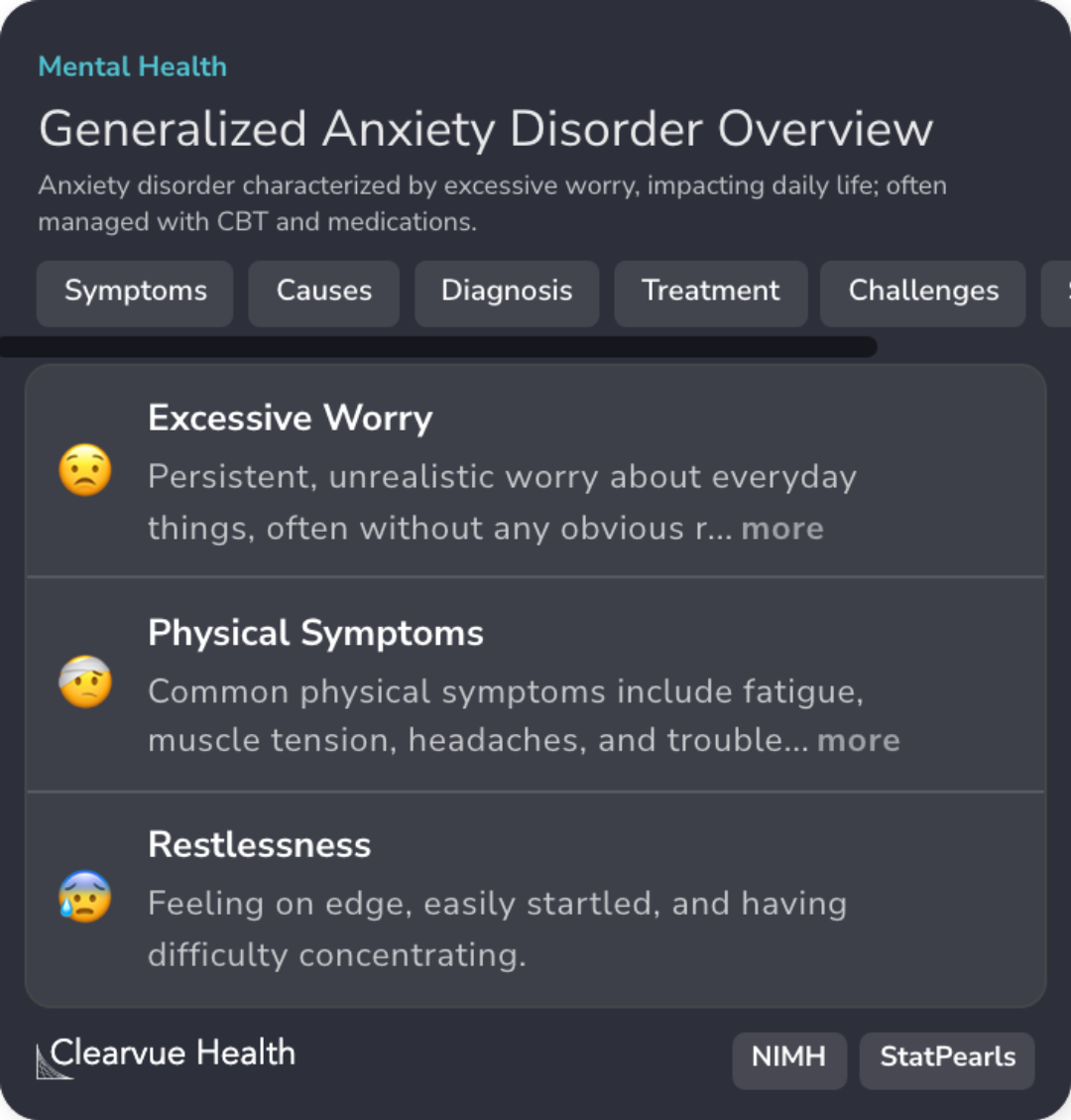
Professional Guide
Expert Opinion: Perseverative thought as a predictor in GAD and MDD
The findings suggest a strong link between perseverative thought (PT) and negative responses in GAD and MDD. Current professional recommendations state that GAD is characterized by excessive worry and frequent comorbidity with MDD.
Genetic factors and neurotransmitter disturbances contribute to the development of GAD, sharing common heritability with major depression.
Cognitive-behavioral therapy (CBT) is effective in addressing GAD symptoms using reasoning exercises and has demonstrated comparable effectiveness across various populations.
Genetic factors and neurotransmitter disturbances contribute to the development of GAD, sharing common heritability with major depression.
Cognitive-behavioral therapy (CBT) is effective in addressing GAD symptoms using reasoning exercises and has demonstrated comparable effectiveness across various populations.
Evidence Summary
Mindfulness for Managing Anxiety
Mindfulness techniques can help individuals with generalized anxiety disorder (GAD) manage their emotions better, reducing the persistent worry that characterizes the condition. Practicing mindfulness helps people regulate their emotions more effectively.
Generalized anxiety disorder involves constant and excessive worry, but incorporating mindfulness practices has been shown to alleviate these symptoms over time.
Generalized anxiety disorder involves constant and excessive worry, but incorporating mindfulness practices has been shown to alleviate these symptoms over time.
Evidence Summary
Brain Differences in Error Processing Between GAD and MDD
The study examines how the brains of people with Generalized Anxiety Disorder (GAD) and Major Depressive Disorder (MDD) process errors. Brain imaging reveals both similarities and differences in how individuals with GAD alone and those with comorbid MDD react to mistakes.
By comparing brain activity, the research sheds light on distinct neural responses in individuals with GAD versus those who also have MDD, specifically in error-related tasks.
By comparing brain activity, the research sheds light on distinct neural responses in individuals with GAD versus those who also have MDD, specifically in error-related tasks.
Evidence Summary
Mindfulness and Acceptance as Keys to Managing GAD
Acceptance-based therapy helps people manage Generalized Anxiety Disorder by encouraging them to acknowledge anxious thoughts and emotions, rather than trying to get rid of them. It emphasizes mindfulness and emotional acceptance, which can reduce the intensity of anxiety symptoms.
By focusing on living with anxiety rather than eliminating it, the therapy offers skills that promote long-term emotional well-being for individuals with GAD.
By focusing on living with anxiety rather than eliminating it, the therapy offers skills that promote long-term emotional well-being for individuals with GAD.



